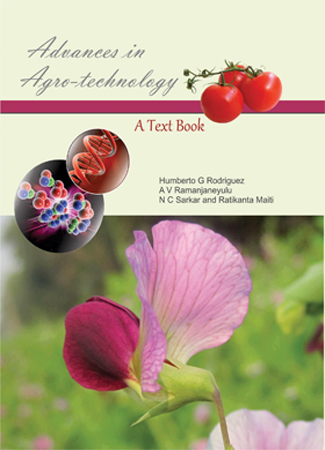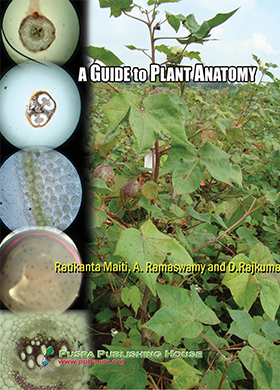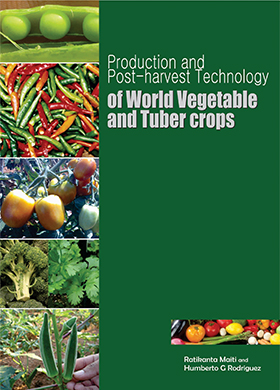Full Research
Estimation of Phytochemicals from Mother Plants and In vitro Raised Plants of Gloriosa superba
Sneh Sharma, Bandna Devi and Vivek Sharma
- Page No: 127 - 130
- Published online: 19 Aug 2021
- DOI: HTTPS://DOI.ORG/10.23910/2/2021.0430
-
Abstract
-
snehasharma_ss@yahoo.co.in
Gloriosa superba L. is an important endangered medicinal plant and widely used in Indian system of medicine. All the parts of Gloriosa superba keeps several biological activities such as antioxidant, antimicrobial, antibacterial and anthelmintic properties. This is due to the presence of different phytochemicals like alakloids, flavonoids, phenols, tannins, glycosides, saponins, carbohydrates, steroids and minerals in tubers, leaves and stem. Methanol extract of leaves of mother plant showed higher phenolic content (93.80±0.22 mg GAE g-1) and flavanoids (11.47±0.26 mg QE g-1) than in in vitro raised plants. Acetone extract of stem of mother plant showed highest concentration of tannins (70.83±0.88 mg TAE g-1).
Keywords : In vitro, micropropagation, phytochemicals, secondary metabolites
-
Introduction
Life of a man has always been intensively connected with the nature surrounding him and plants affect every aspect of our lives. Plants have been used by human beings for various purposes like nourishment, defense, protection, food, fiber, medicine and decoration. Human beings are using compounds derived from plants for treating diseases since ancient times. Medicinal plants offer alternative remedies with tremendous opportunities which not only provide access and affordable medicine to poor people but also generate income, employment and foreign exchange for developing countries (Kumbhare et al., 2012). Plants generally produce many secondary metabolites which constitute an important source of microbiocides, pesticides and many other important pharmaceutical drugs (Ibrahim, 1997). From a long period of time, medicinal plants or their secondary metabolites have been directly or indirectly used to cure diseases and recently became of great interest owing to their versatile applications (Wink et al., 2009). Medicinal plants are known to be the richest bio-resource of drugs of traditional system of medicines, modern medicines, food supplements, neutraceuticals, pharmaceutical intermediates and chemical entities or synthetic drugs (Tiwari et al., 2011).
Gloriosa superba L. is an important medicinal plant of Colcicaceae family, commonly known as Kalihari, Creeping lily, Flame lily, Glory lily, Agnishikha, Nangulika and Tiger claw. All the parts of this plant are used for medicinal purposes in Siddha, Ayurveda and Yunani system of medicine due to the presence of toxic alkaloids such as Colchicine and its derivatives like Gloriosin and Colchicocide along with benzon acid, salicylic acid and resinous substances. Medicines of this plant with major secondary metabolism, tropolone type are present in alkaloids, seeds and tubers (Maroyi and Van der Maesen, 2011). The Flame lily exhibits a broad spectrum of functions to get rid of constipation, anti-inflammatory efficacy, antimicrobial, larvisic test, antibacterial energy, anti-depressant energy, enzyme resistance, serpent bite, skin diseases and respiratory disorders (Ade and Rai, 2009; Hemaiswarya et al., 2009). It is found to be suitable for treatment of injuries and sprains, bitterness, chronic injuries, hemorrhoids, cancers, labor pain and abortion (Srivastava and Chandra, 1977). Gloriosa was only found in the wild a decade back but now it has been domesticated for economic gain and all the parts of the plant are utilized in Indian medicine. Being rich in several biologically active compounds this plant species could serve as potential source of drugs that can be used as a complementary source of traditional medicines.
Gloriosa superba is one of the major medicinal plants in India cultivated for its seeds which are exported to developed countries for pharmaceutical use. However, not much is known about the chemical composition of the plant leaves and tubers (Chitra and Rajamani, 2009). The major aim of this work was to perform in vitro regeneration and preliminary phytochemical studies among in vitro and mother plant of Gloriosa superba.
-
Materials and Methods
2.1. Plant material and extract preparation
Fresh parts (leaf and stem) of mother as well as in vitro raised plants were used as plant material and then extract was prepared. For extract preparation two solvents, acetone and methanol were used. The samples were washed with distilled water and then dried in room temperature. 100 ml of different solvents (methanol and acetone) were used for homogenization of dried tissues and then extraction was carried out in orbital shaker at 150 rpm for 24 hours. After that, the mixtures were centrifuged at 10000 rpm for 10 min. Supernatant was then filtered through Whatman filter paper (No. 1). UV-Vis spectrometer (Thermo scientific) was used for the estimation of biochemical parameters.
2.2. Quantitative estimation of total phenolic content (TPC)
Folin-Ciocolteu method was used for the estimation of total phenolic content (Singelton and Rossi, 1965). 0.1 ml of extract was mixed with 1.8 ml of Folin-Ciocolteu reagent (ten times diluted) and kept for 6 min at 25°C. Then 1.2 ml of 20% Na2CO3 was added to the reaction mixture. It was then kept for one and half hour at room temperature. Absorbance was measured at 765 nm using UV-Vis spectrophotometer (Thermo scientific). Concentration of TPC was determined as mg of gallic acid equivalent (GAE) per gram of tissue using an equation obtained from gallic acid calibration curve.
2.3. Quantitative estimation of total flavanoid content (TFC)
For the estimation of total flavanoid content, the aluminium chloride colorimetric method was used with some modifications (Chang et al., 2002). 0.5 ml of extracts, 1.5 ml of methanol, 0.1 ml of aluminium chloride (10%), 0.1 ml of sodium acetate (1 M) and 2.8 ml of distilled water was mixed for 5 min by vortexing. The reaction mixture was kept at room temperature for 30 min and the absorbance was measured at 415 nm. The calibration curve was prepared for quercetin and the results were expressed as mg of quercetin equivalents (QE) per gram of tissue.
2.4. Quantitative estimation of total tannin content (TTC)
Total tannin content was measured by using the Folin–Dennis method (Singelton et al., 1999). 0.2 ml of extracts was mixed with 0.5 ml of Folin–Dennis reagent. 1 ml of 20% sodium carbonate solution and 1 ml of millipore water was added thereafter. The reaction mixture was incubated at room temperature for 30 min. The absorbance of the reaction was measured at 775 nm. The concentration of total tannin was determined as mg of tannic acid equivalents (TAE) per gram of tissue using an equation obtained from the tannic acid calibration curve.
To calculate the concentration of the content, formula used is as follow:
Concentration (mg)=(X×Total volume×100)/(Aliquot taken×Weight of sample (g))
2.5. Statistical analysis
Experiments were set up in a completely randomized block (CRD) design and each experiment has three replicates (Cochran and Cox, 1963; Gomez and Gomez, 1984). The data was analyzed using one-way and two-way analysis of variance (ANOVA). The statistical analysis was carried out by using MS-Excel and OPSTAT.
-
Results and Discussion
The present investigation was carried out to compare the concentration of different secondary metabolites of mother plant and in vitro raised plants of Gloriosa superba. The plants for phytochemical estimation were selected according to morphology. Extract of fresh leaves and stem of mother as well as in vitro raised plants was prepared by using different solvents (Acetone and methanol).
3.1. Quantitative estimation of total phenolic content (TPC)
Methanolic and acetone extract of leaves and stem of mother and in vitro raised plants showed variations in phenolic content. Methanol extract of leaves of mother plant showed higher (93.80±0.22 mg GAE g-1) phenolic content than in in vitro raised plants. Lowest phenolic content was recorded in acetone extract of stem of in vitro raised plants (19.73±0.33 mg GAE g-1) (Table 1, Figure 1). Similar observations were recorded in Salacia chinensis, Hypochaeris radicata , where methanol extract of leaf and root parts showed higher phenolic content than that of other solvent extract (Chavan et al., 2012; Senguttuvan et al., 2014).
3.2. Quantitative estimation of total flavanoid content (TFC)
Methanolic and acetone extract of leaves and stem of mother and in vitro raised plants showed variations in flavanoid content. The solubility of flavanoids was significantly affected by the solvent used for extraction and these findings are in accordance with the results obtained for Asimina tribloba and S. Chinensis (Harris and Brannan, 2009; Chavan et al., 2012). Methanol leaves extract of mother plant showed higher concentration of flavanoids i.e. 11.47±0.26 mg QE g-1. Acetone extract of stem of in vitro raised plants showed lowest concentration of flavanoids i.e. 1.50±0.00 mg QE g-1 (Table 2, Figure 2). The same findings were also reported in Dendrobium nobile where methanol leaf extract showed higher flavanoid content (Bhattacharya et al., 2014).
3.3. Quantitative estimation of total tannin content (TTC)
Methanolic and acetone extract of leaves and stem of mother and in vitro raised plants showed variations in tannin content. Acetone extract of stem of mother plant showed highest concentration of tannins (70.83±0.88 mg TAE g-1), whereas methanol extract of leaves of in vitro raised plants showed lowest concentration of tannins (14.90±0.20 mg TAE g-1 DW) (Table 3, Figure 3).
In the present investigation, phenolic, flavanoid and tannin contents showed variations among mother plant and in vitro raised plants in different plant parts (leaves and stem) in different solvents. These variations may be due to the hormonal content, specific metabolic as well as endogenous physiological changes taking place in the plants. Similar variations of phenolics and flavanoid content within plant parts were reported in 12 medicinal plants of the families Asclepiadaceae and Periplocaceae (Surveswaran et al., 2010). A number of factors, such as somaclonal variation, plant-to-plant variation in chemical content and variation in agroclimatic conditions are responsible for overall discrepancy between field and in vitro plants (Ciddi, 2006). It appears to be pertinent to accept the in vitro system which may serve as alternative source of metabolites and thus may be exploited for efficient generation of such substances throughout the year, which are pharmacologically promising but are severely limited in production.
-
Conclusion
Among in vitro and mother plants, mother plants showed highest phenolics, flavanoids content whereas tannin content was high in in vitro raised plants. Moreover, preliminary phytochemical analysis can further be utilized for identification of best provenances for large scale production through biotechnological intervention. A study to promote mass multiplication and quantification of active constituents is recommended in order to achieve maximum benefits from high value medicinal plants in the region.
-
Acknowledgement
Authors are grateful to the Department of Biotechnology, College of Horticulture and Forestry, Neri Hamirpur (H.P.) for providing the facilities for research work.
Table 1: Determination of total phenolic content in Gloriosa superba
Figure 1: comparison of TPC between mother plant and in vitro raised plants
Table 2: Determination of total flavanoid content in Gloriosa superba
Figure 2: comparison of TFC between mother plant and in vitro raised plants
Table 3: Determination of tannin contents in Gloriosa superba
Figure 3: Comparison of TTC between mother and in vitro raised plants
Table 1: Determination of total phenolic content in Gloriosa superba
Figure 1: comparison of TPC between mother plant and in vitro raised plants
Table 2: Determination of total flavanoid content in Gloriosa superba
Figure 2: comparison of TFC between mother plant and in vitro raised plants
Table 3: Determination of tannin contents in Gloriosa superba
Figure 3: Comparison of TTC between mother and in vitro raised plants
Table 1: Determination of total phenolic content in Gloriosa superba
Figure 1: comparison of TPC between mother plant and in vitro raised plants
Table 2: Determination of total flavanoid content in Gloriosa superba
Figure 2: comparison of TFC between mother plant and in vitro raised plants
Table 3: Determination of tannin contents in Gloriosa superba
Figure 3: Comparison of TTC between mother and in vitro raised plants
Table 1: Determination of total phenolic content in Gloriosa superba
Figure 1: comparison of TPC between mother plant and in vitro raised plants
Table 2: Determination of total flavanoid content in Gloriosa superba
Figure 2: comparison of TFC between mother plant and in vitro raised plants
Table 3: Determination of tannin contents in Gloriosa superba
Figure 3: Comparison of TTC between mother and in vitro raised plants
Table 1: Determination of total phenolic content in Gloriosa superba
Figure 1: comparison of TPC between mother plant and in vitro raised plants
Table 2: Determination of total flavanoid content in Gloriosa superba
Figure 2: comparison of TFC between mother plant and in vitro raised plants
Table 3: Determination of tannin contents in Gloriosa superba
Figure 3: Comparison of TTC between mother and in vitro raised plants
Table 1: Determination of total phenolic content in Gloriosa superba
Figure 1: comparison of TPC between mother plant and in vitro raised plants
Table 2: Determination of total flavanoid content in Gloriosa superba
Figure 2: comparison of TFC between mother plant and in vitro raised plants
Table 3: Determination of tannin contents in Gloriosa superba
Figure 3: Comparison of TTC between mother and in vitro raised plants
-
Ade, R., Rai, M.K., 2009. Review: Current advances in Gloriosa superba L. Biodiversitas 10, 210–214.
Bhattacharya, P., Kumaria, S., Diengdoh, R., Tandon, P., 2014. Genetic stability and phytochemical analysis of in vitro regenerated plants of Dendrobium nobile Lindl., an endangered medicinal orchid. Meta Gene, 489–504.
Chang, C., Yang, M., Wen, H., Chern, J., 2002. Estimation of total flavanoid contents in Propolis by two complementary colorimetric methods. Journal of Food and Drug Analysis 10(3), 178–182.
Chavan, J.J., Jagtap, U.B., Gaikwad, N.B., Dixit, G.B., Bapat, V.A., 2012. Total phenolics, flavonoids and antioxidant activity of Saptarangi (Salacia chinensis L.) fruit pulp. Journal of Plant Biochemistry and Biotechnology 4, 409–413.
Chitra, R., Rajamani, K., 2009. Precise performance and correlation studies for yield and its quality characters in Glory lily Gloriosa superb (L.). Academic Journal of Plant Sciences 2, 39–43.
Ciddi, V., 2006. Withaferin A from cell cultures of Withania somnifera. Indian Journal of Pharmaceutical Sciences 26(6), 490–492.
Cochran, W.G., Cox, G.M., 1963. Experimental Design. Asian Publishing House, New Delhi.
Gomez, K.Z., Gomez, A.A., 1984. Statistical procedures for agricultural research. John Wiley and Sons, New York.
Harris, G.G., Brannan, R.G., 2009. A preliminary evaluation of antioxidant compounds, reducing potential and radical scvavenging of pawpaw (Asimina triloba) fruit pulp from different stages of ripeness. LWT- Food Science and Technology 42, 275–279.
Hemaiswarya, S., Raja, R., Anbazhagan, C., Thiagarajan, V., 2009. Antimicrobial and mutagenic properties of the root tubers of Gloriosa superba L. Pakistan Journal of Botany 41, 293–299.
Ibrahim, M.B., 1997. Anti-microbial effects of extract leaf, stem and root bark of Anogeissus leiocarpus on Staphylococcus aureaus, Streptococcus pyogenes, Escherichia coli and Proteus vulgaris. Journal of Pharmaceutics and Drug Development 2, 20–30.
Kumbhare, M.R., Guleha, V., Udavant, P.B., Dhake, A.S., Surana, A.R., 2012. In vitro antioxidant activity, photochemical screening, cytotoxicity and total phenolic content in extracts of Caesalpinia pulcherrima (Caesalpiniaceae) pods. Pakistan Journal of Biological Sciences 15, 325–332.
Maroyi, A., Van der Maesen, L.J., 2011. Gloriosa superba L. (family colchicaceae): Remedy or poison? Journal of Medicinal Plant Research 5, 6112–6121.
Senguttuvan, J., Paulsamy, S., Karthika, K., 2014. Phytochemical analysis and evaluation of leaf and root parts of the medicinal herb, Hypochaeris radicata L. for in vitro antioxidant activities. Asian Pacific Journal of Tropical Biomedicine 4(1), 359–367.
Singelton, V.L., Orthofer, R., Laumela-Raventos, R.M., 1999. Analysis of total phenols and other oxidation substrates and other antioxidants by means of Folin-Ciocolteu reagent. Methods in Enzymology 299, 152–178.
Singleton, V.L., Rossi, J.A., 1965. Colorimetry of total phenolics with phosphomolybdic- phosphotungstic acid reagents. American Journal of Enology and Viticulture 16, 144–158.
Srivastava, U.C., Chandra, V., 1977. Gloriosa superba Linn. (Kalihari)- an important colchicine producing plant. Indian Journal of Medical Research 10, 92–95.
Surveswaran, S., Cai, Y.Z., Xing, J., Corke, H., Sun, M., 2010. Antioxidant properties and principal phenolic phytochemicals of Indian medicinal plants from Asclepia daceae and Periplocaceae. Natural Product Research 24, 206–221.
Tiwari, P., Kumar, B., Kaur, M., Kaur, G., Kaur, H., 2011. Review of phytochemical screening and extraction process. Internationale Pharmaceutica sciencia 1(1), 25–30.
Wink, M., Franke, R., Wetterauer, B., Distl, M., Windhovel, J., Krohn, O., Fuss, E., Garden, H., Mohagheghzadeh, A., Wildi, E., Ripplinger, P., 2005. Sustainable bioproduction of phytochemicals by plant in vitro cultures: anticancer agents. Plant Genetic Resources 3, 90–100.
Reference
Cite
Sharma, S., B, , Devi, n., Sharma, V. 2021. Estimation of Phytochemicals from Mother Plants and In vitro Raised Plants of Gloriosa superba . International Journal of Economic Plants. 8,1(Aug. 2021), 127-130. DOI: https://doi.org/10.23910/2/2021.0430 .
Sharma, S.; B, ; Devi, n.; Sharma, V. Estimation of Phytochemicals from Mother Plants and In vitro Raised Plants of Gloriosa superba . IJEP 2021,8, 127-130.
S. Sharma, B, n. Devi, and V. Sharma, " Estimation of Phytochemicals from Mother Plants and In vitro Raised Plants of Gloriosa superba ", IJEP, vol. 8, no. 1, pp. 127-130,Aug. 2021.
Sharma S, B , Devi n, Sharma V. Estimation of Phytochemicals from Mother Plants and In vitro Raised Plants of Gloriosa superba IJEP [Internet]. 19Aug.2021[cited 8Feb.2022];8(1):127-130. Available from: http://www.pphouse.org/ijep-article-details.php?art=283
doi = {10.23910/2/2021.0430 },
url = { HTTPS://DOI.ORG/10.23910/2/2021.0430 },
year = 2021,
month = {Aug},
publisher = {Puspa Publishing House},
volume = {8},
number = {1},
pages = {127--130},
author = { Sneh Sharma, B, na Devi , Vivek Sharma and },
title = { Estimation of Phytochemicals from Mother Plants and In vitro Raised Plants of Gloriosa superba },
journal = {International Journal of Economic Plants}
}
DO - 10.23910/2/2021.0430
UR - HTTPS://DOI.ORG/10.23910/2/2021.0430
TI - Estimation of Phytochemicals from Mother Plants and In vitro Raised Plants of Gloriosa superba
T2 - International Journal of Economic Plants
AU - Sharma, Sneh
AU - B,
AU - Devi, na
AU - Sharma, Vivek
AU -
PY - 2021
DA - 2021/Aug/Thu
PB - Puspa Publishing House
SP - 127-130
IS - 1
VL - 8
People also read
Full Research
Valerian and Yarrow: Two medicinal Plants as Crop Protectant Against Late Frost
M. Stefanini, L. Merrien, P. A. MarchandValerian, Yarrow, plant extract, plant protection, elicitor, anti-freezing action, hail damages
Published Online : 28 Nov 2018
Full Research
Lecithins: A Food Additive Valuable for Antifungal Crop Protection
M. Jolly, R. Vidal and P. A. MarchandLecithins, fungicide, biopesticide, downy mildew, powdery mildew
Published Online : 28 Aug 2018
Review Article
Neem (Azadirachta indica): A Review on Medicinal Kalpavriksha
I. V. Srinivasa Reddy and P. NeelimaAzadirachata, chemistry, medicinal properties, neem, pharmacological
Published Online : 26 Feb 2022
Review Article
Status of Bamboo in India
Salil Tewari, Harshita Negi and R. KaushalArea, bamboo, cultivation, diversity, India, species
Published Online : 28 Feb 2019
Studies on Leaf Blight Disease of Sissoo (Dalbergia sissoo Roxb.) in Bangladesh
S. Chowdhury, H. Rashid, R. Ahmed and M. M. U. HaqueConidia, lesions, morphology, pathogenicity, sissoo
Published Online : 16 Oct 2020
Full Research
Biological Management of Grey Leaf Blight (Pestalotia anacardii) of Mango (Mangifera indica)
V. A. Patil, B. P. Mehta and A. J. DeshmukhAntagonists, grey leaf blight, Kesar, Pestalotia anacardii
Published Online : 28 May 2019



.jpg)
.jpg)






